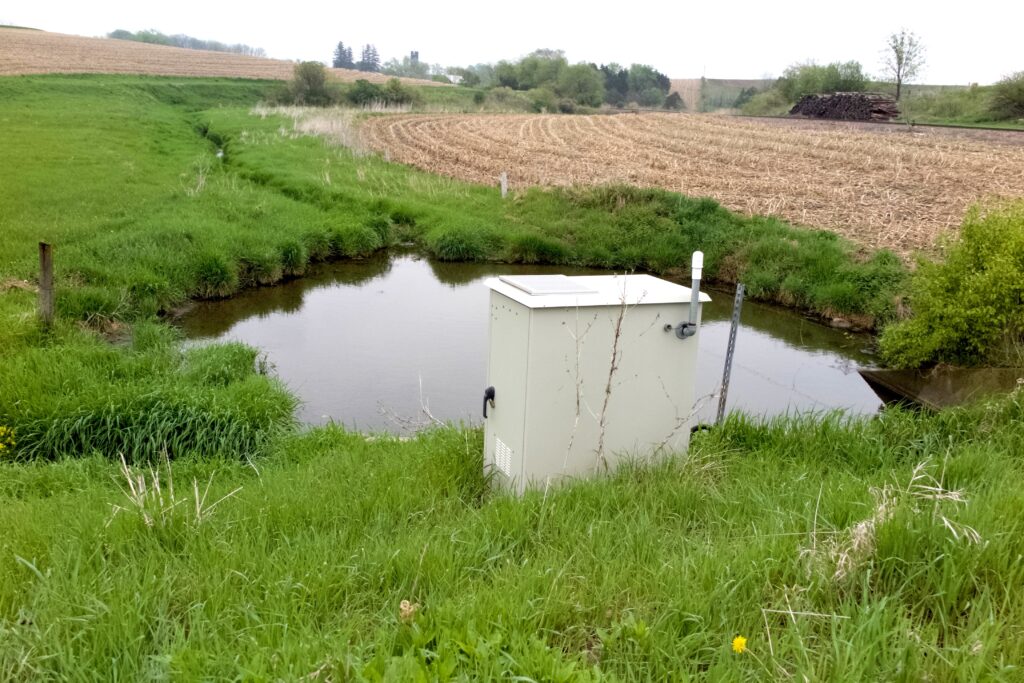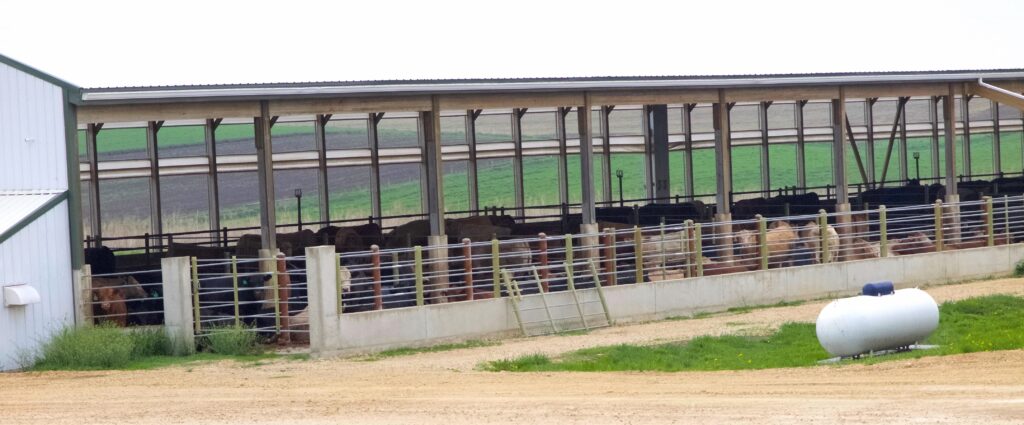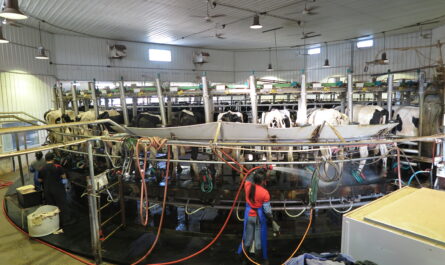
shut down Chris Jones’ blog at the University of Iowa. (Photo/Keith Schneider)
IOWA CITY, IOWA — There’s no mystery that fertilizer and manure running off farm fields are the primary cause of Iowa’s wretched water quality. Farm fields laden with synthetic fertilizers and manure produce bounties of over 2 billion bushels of corn each year. Data from the Iowa Water Quality Information System, the state’s advanced monitoring network, shows those same fields also produce a torrent of run-off that contaminates virtually every mile of streams and rivers – and every acre of lakes and ponds.
For Iowa’s farm sector and its powerful political allies, the dire public and environmental consequences are perhaps unfortunate, but acceptable, outcomes of modern, large-scale agriculture and, importantly, a topic best kept out of the spotlight.
So there was nothing ambiguous about the message two senior Republican Iowa state senators conveyed in late March to Keith Saunders, the University of Iowa’s chief lobbyist. Sen. Dan Zumbach, the chair of the Senate Agriculture Committee, and Sen. Tom Shipley, chair of the Senate Ethics Committee, told Saunders they wanted to silence a widely read university-sponsored blog that aggressively reported on farm-related nutrient contamination.
What occurred next in Iowa is a rare and vivid public illustration of the power of agriculture to evade responsibility for it mammoth waste stream. Within days the university killed the blog. The state’s most prominent authority on the deteriorating quality of state waters resigned his university post. Weeks later the Legislature voted to defund the nutrient monitoring network, one of the world’s best.

Few instances of political bullying, academic intimidation, and information repression have ever been so visible in or outside Iowa. The genesis was an influential lawmaker’s very personal interest. Sen. Zumbach’s son-in-law is co-owner of a big cattle feeding operation close to Bloody Run Creek, a cold water trout stream in northeast Iowa. The feedlot, Supreme Beef, lies just upstream of one of the water quality monitoring stations.
Sen. Zumbach did not respond to requests for comment for this article. In an interview with the Iowa Capital Dispatch the senator’s standing as a power broker was on full display. Sen. Zumbach told the online non-profit news organization that he didn’t need to put the university’s budget in peril to accomplish his goal. “No threat to funding was ever made because of the content of a blog,” he said.
A Researcher Attacked
The target of Zumbach’s attack was Chris Jones, the blog’s 62-year-old author. A Ph.D. chemist and research engineer working out of the University of Iowa Institute of Hydraulic Research (IIHR), Jones was recruited from the Iowa Soybean Association in 2015 specifically to lead the Iowa Water Quality Information System, which he built from 12 sensing stations to 66 at a cost of $3 million. He’s particularly proud of the interactive online map of every station location and their continuously reported data.
Jones’ mastery of all the data flowing into his office, including from Bloody Run Creek, filled state reports and contributed to dozens of peer-reviewed journal articles. Yet Jones’s renown in Iowa was due to the blog he started soon after joining the university. He displayed his moxie and puckish writing style in popular weekly posts that assailed Iowa’s reluctance to account for the farm sectors flood of toxic nutrient wastes. In one 2020 post, “Don’t P Down My Leg and Tell Me It’s Raining,” he disputed the state’s finding that phosphorus discharges from agriculture were diminishing. In another titled “Breaking Wind,” he scoffs at Iowa’s claim that climate change is good for farmers.
One of his favorite topics was a program Iowa established with great fanfare in 2012 in an attempt to affirm its resolve to deal with water pollution — the Iowa Nutrient Reduction Strategy. The program’s expensive mission, $500 million in 2018 alone, and more in the years before and since, is to pay farmers, and livestock and poultry producers to voluntarily change practices to limit discharges of polluting nitrogen and phosphorus.
Jones’ assessment, based on continuous monitoring from streams and rivers — what university administrators called “the backbone” of the nutrient strategy — was consistent and unassailable. Not only is the reduction strategy not working, he reported, the state’s ever more intensive industrial farm practices are pouring more nutrients into Iowa’s s streams and rivers. Water pollution is getting worse.
“So here’s what’s behind the killing of the blog and the sensor network,” said Jones in an interview. “These guys now are going to own all the messaging. They’re going to be able to say whatever they want about progress towards nutrient management goals. There’s not going to be anyone here to do these calculations and use the sensor data to draw conclusions about what’s in the water.”
Neither Sen. Shipley nor Keith Saunders responded to requests for interviews. Nor did Larry Weber, Jones’ boss and the director of the IIHR, who shut down the blog.
On May 15 the university issued this timid response: “Faculty and staff must have the ability to teach and conduct research without fear of suppression. The president and provost have been very consistent in their support of academic freedom.â€
On May 16 Chris Jones departed the university. “Future generations of Iowans will think about this: We knew our water was degraded. We knew what caused the degradation,” Jones has written. “We didn’t fix it because we lacked the courage to confront the forces that kept us locked into a status quo preferred by only a few.”
Iowa’s Very Troubled Waters
Those forces are expert in protecting Iowa’s interest in allowing the $35 billion crop and livestock sector to pollute state waters. Six years ago, in another revealing example, Des Moines Water Works filed a federal lawsuit to regulate nitrogen discharges from farms upstream of its Raccoon River treatment plant. High concentrations of nitrates, which form when nitrogen unites with oxygen, contaminated drinking water for 500,000 residents. The case ignited farm industry fury, was assailed by then Republican Governor Terry Branstad as a “war on Iowa farmers,” and summarily dismissed in 2017 by Leonard T. Strand, the chief judge of the U.S. District Court for northern Iowa.
Jones joined the university the year the water utility brought its case to federal court. As a veteran environmental scientist he was already an expert on Iowa’s serious water quality dilemma — the addiction of its largest industry to polluting farm-nutrients, particularly nitrogen.
More than 11 billion pounds of nitrogen fertilizer are spread on American corn fields. As the country’s largest corn producer Iowa growers apply about 2 billion pounds annually on nearly 13 million acres. Though researchers disagree about how much nitrogen is needed to grow marketable quantities of corn, here is what’s not in dispute. Growing plants take up as little as 30 percent of what farmers spread. The rest, as much as 7 of every 10 pounds, runs off the land as nitrate into ditches and streams.
Then there’s nitrates produced by Iowa’s immense livestock and poultry producers. In one particularly popular post Jones calculated that manure produced and haphazardly spread on the land from Iowa’s 22 million hogs, 250,000 dairy cows, 1.8 million beef cattle, and 85 million chickens and turkeys was equivalent to the fecal waste produced by 134 million people.
With data from the sensing network, Jones described in masterful detail just how foul Iowa’s waters had become. Virtually every one of the 72,000 miles of streams in Iowa is polluted with various concentrations of nitrogen. The contamination is not confined to the state. Based on his analysis, 1 billion pounds of Iowa nitrogen drains into the Mississippi River annually, accounting for nearly 30 percent of the nutrients responsible for causing the Gulf of Mexico dead zone at the rivers’ mouth.
“This is a national story,” David Cwiertney, the director of the Center for Health Effects of Environmental Contamination at the University of Iowa, said in an interview. We’re getting rid of the monitoring program that is the best way to understand a leading source of the nitrogen that’s driving the dead zone. Are you now just free to pollute?

and a prominent clean water advocated. (Photo/Keith Schneider)
That is certainly the case in Iowa. The state has documented more than 7,000 private water wells contaminated with nitrates. Most state residents consume measurable levels of nitrates in their drinking water, according to Cwiertney, professor of civil and environmental engineering at the University of Iowa. “We have 3 million residents in the state,” he said. “The majority of Iowans have nitrate, at some level, safe or otherwise, in their tap water.”
Exposure to nitrates from Iowa’s farm sector may be a factor in the state’s deteriorating health. Peer-reviewed studies have found long-term exposure to nitrates in drinking water is linked to uterine, rectal, bladder, and ovarian cancers in women. In February, the Iowa Cancer Registry, in its 50th annual report, found Iowa is the only state with a significant increase in cancer from 2015 to 2019, and has the second-highest overall cancer incidence of all states.
It Started On A Creek
Bloody Run Creek, tucked into the hills of Clayton County and barely a yard wide where it starts, is an improbable place for a 21st century tale of political coercion. Unless it’s about water. The creek is one of 34 streams designated by the state Department of Natural Resources as an “outstanding” Iowa water way.

prompted a lawmaker’s attack on Chris Jones, a prominent water quality researcher. (Photo/Keith Schneider)
Perched in the tall grass where Bloody Run Creek drains the rolling farm fields of Clayton County is one of the sensing stations, WQS0114, that Jones installed to monitor water quality. It’s white metal box that contains electronic gear capable of measuring the concentration of nitrogen in Bloody Run every second of every day, and has since it began operating five years ago. That sensor, those readings, and Jones’ reporting activated Sen. Zumbach’s ire.
Jones, an avid outdoorsman, knows the stream and the region intimately. He owns a cabin close by across the Mississippi River in Wisconsin. “All things considered, a person might expect that our government would tenaciously protect, and our industries would respect, Bloody Run Creek and the other outstanding waters,” he wrote in a 2021 post.
The DNR did not comply. It approved a nutrient management plan that allowed Supreme Beef to feed 11,600 head annually. Zumbach apparently had a role in the decision. He intervened with Kayla Lyon, the DNR director, on behalf of Supreme Beef.
The state chapters of the Sierra Club and Trout Unlimited filed suit to nullify the DNR nutrient management plan and reduce the size of the feedlot. Residents filed a formal ethics complaint with the state Senate asserting Zumbach “improperly used his position as a state senator to influence decisions by a regulatory agency.†Zumbach’s legislative colleagues dismissed the complaint following a public hearing.
Jones weighed in with a masterful blog post. He reported that the 30.5 million gallons of manure produced by 11,600 beef cattle contained 1.2 million pounds of nitrogen and 762,000 pounds of phosphorus. In order to get rid of all that fecal nutrient, he wrote, Supreme Beef would have to spread vastly more nutrients on its corn fields that was needed for ample harvests.
It was bound to reach Bloody Run Creek and encourage plant and algae growth that would decay, depleting oxygen levels in the water, and harm the fishery. During the past two years data from station WQS0114 shows that Bloody Run Creek has some of the highest nitrogen concentrations of any Iowa stream.
“Are we not allowed to have even 34 outstanding waters?” Jones wrote, “Apparently not. If agriculture is allowed to take Bloody Run, rest assured they will take the other 33.”

nutrient management plan to feed 11,600 beef cattle annually. (Photo/Keith Schneider)
Though Iowa Lawmakers are intent on ceasing operations for Jones’ water monitoring program, advocates for cleaner Iowa waters notched a small victory earlier this month when the Sierra Club and Trout Unlimited won their case against the state and Supreme Beef. A state district court judge ordered the state to develop a new manure management plan. The plaintiffs asserted the new plan needs to substantially reduce the size of the herd.
Jones hasn’t reported on the new details in his writing. He’s busy pursuing an unexpected and promising new path as an independent columnist and author. Jones posts on a new Substack blog that already counts 900 subscribers, 101 paying. And “The Swine Republic,” a collection of his university blog posts, was published in May by Ice Cube Press. Jones’ promotional appearances are attracting overflow audiences.
“I think your right to enjoy nature, and especially, clean water, should not be debased by the fact that you’re surrounded by farmable land,” Jones wrote in one of his last university posts. “It’s not uncommon to hear some variation of ‘we’re a farm state, get used to it.’ I reject that. And I think if the state is to have a prosperous future, it needs to be rejected by the masses. That rejection has been out in front of every essay that I have posted.”
— Keith Schneider
This report, co-published with The New Lede and Circle of Blue, was made possible by an investigative reporting fellowship awarded by the Alicia Patterson Foundation.


3 thoughts on “In Iowa, A Tale of Academic Intimidation and Contaminated Water”